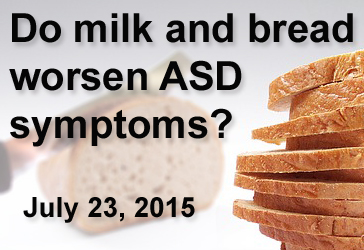Categories
Select a new category
Eye-Tracking Study in Infants Finds Pattern for ASD
By Chelsea Toledo, M.A. on June 12, 2019
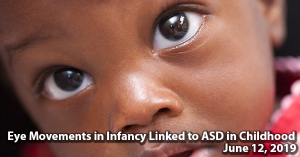
Background: Autism spectrum disorder (ASD) is characterized by differences in communication, social interaction and behavior. Although the average age for a child to receive an ASD diagnosis is 4 years old, researchers have uncovered patterns in infants and toddlers who go on to be diagnosed. One potential indicator among the youngest children is differences in visual attention, or gaze.
What’s New: A recent study identified patterns in the joint attention – the process of looking at something alongside another person – among 10-month-old infants. The researchers conducted a series of tasks with 112 infants, 81 of whom had older siblings with ASD. Tasks were designed to assess the infants’ response to cues for joint attention (such as turning to look at a puppet), as well as how the infants initiated joint attention themselves (such as giving the infant an opportunity to point at flashing lights).
Repeating the assessments at 14 and 18 months and following up at 36 months, the researchers found:
- 22 of the children whose older siblings had ASD were later diagnosed, as well.
- Responses to cues for joint attention were not linked to rates of ASD diagnoses, but were linked to familial risk (i.e., infants who had older siblings with ASD were more likely to have low scores on this task, whether or not they were ultimately diagnosed themselves).
- The infants’ tendency to initiate joint attention was markedly different among those ultimately diagnosed with ASD, who had both lower scores in this area and atypical development of this skill between 10 and 18 months.
Why it’s important: This study suggests observable indicators of ASD may appear as early as 10 months of age. Future research could lead to earlier diagnosis and intervention.
Help me understand :
| Source(s) : |
| Tweet |
Molecular Biomarker May Predict GI Symptoms in ASD
By Chelsea Toledo, M.A. on April 26, 2019
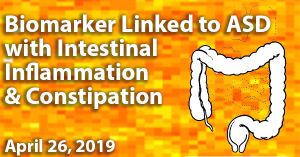
Background: For decades, researchers have suspected a link between Autism Spectrum Disorder (ASD) and gastrointestinal (GI) symptoms. The GI symptoms frequently reported in ASD include abdominal pain, constipation, chronic diarrhea, and gastroesophageal reflux disease. Some people with ASD also experience inflammation of the intestines, which respond at various rates to anti-inflammatory therapies.
What’s New: A recent study identified a biomoarker with the potential to predict which individuals with ASD and GI issues would respond quickly or more slowly to anti-inflammatory treatment. The researchers conducted molecular analyses of colon tissue samples from 35 children with ASD. Twenty of those children were found previously to respond slowly to oral anti-inflammatory medicines for GI symptoms, and 15 were fast responders.
Focusing on differences in the early stages of gene expression, the researchers found:
- Fast responders with constipation experienced timely relief after anti-inflammatory therapy, whereas constipation persisted on the right side of slow responders’ colons after treatment.
- Fast responders had greater activity of genetic material related to inflammatory and immune responses
- Slow responders had an increased number of genetic pathways related to the movement of the colon
- The presence of a single molecule could predict whether the children were slow responders to anti-inflammatory therapy.
Why it’s important: This study revealed underlying differences in genetic expression within a group of children with ASD that resulted in predictable GI outcomes. Further research may lead to specialized therapy for people with ASD and GI symptoms.
Help me understand :
| Source(s) : |
| Tweet |
What strategies work for parents of children with ASD?
By Chelsea Toledo, M.A. on October 30, 2018

Background: Autism Spectrum Disorder (ASD) often presents with behavioral issues in children that can be challenging for parents to manage. These include irritability, non-compliance, defiance, and anxiety. These issues tend to be more severe in children with ASD than in those with typical development or those with intellectual disability.
What’s New: Researchers recently conducted a meta-synthesis, combining findings from 69 qualitative studies on strategies leveraged by parents of children with ASD who demonstrated “problem behaviors.” After summarizing these findings, they organized parental strategies into nine categories:
- Accommodating the child
- Modifying the environment
- Providing structure, routine, and occupation
- Supervision and monitoring
- Managing non-compliance with everyday tasks and activities
- Responding to problem behavior
- Managing distress
- Maintaining safety
- Analyzing and planning
Their analysis revealed that parents of children with ASD had to leverage a greater number of strategies to pre-empt and address their children’s behavior than other parents. They also found that the strategies used by parents of children with ASD were more complex than those leveraged by other parents.
Why it’s important: This analysis suggests that parents of children with ASD tailor their approaches to manage specific differences in children with ASD – such as sensory sensitivities or rigidities in routine. Future research could formalize these strategies to aid parents raising children with ASD.
Help me understand :
| Source(s) : |
| Tweet |
Teens with ASD “Compensate” for Better Social Skills
By Chelsea Toledo, M.A. on October 10, 2018
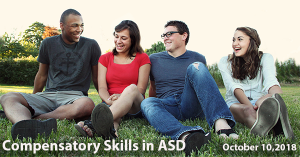
Background: Autism Spectrum Disorder (ASD) is characterized by differences in communication and social behavior. Research has suggested that people with ASD experience deficits in theory of mind – the ability to attribute emotions, beliefs, intents, desires and other mental states to themselves and to others – and that these deficits underlie the social differences perceived among people with ASD. However, people with ASD vary widely in their social abilities. Are there any factor(s) that compensate for impairments in social skills?
What’s New: A recent study set out to determine patterns explaining why some young people with ASD seem to have better social skills than others. In total, 136 participants with ASD between the ages of 10 and 15 – chosen from those already enrolled in the Social Relationships Study in the UK – participated in the study, which involved a series of tasks and questionnaires.
The researchers identified two major groups of interest in this study:
- Low compensators, who had low scores on both the Autism Diagnostic Observation Schedule (ADOS) and the Theory of Mind assessment.
- High compensators, who had high scores on the ADOS in spite of low scores on the Theory of Mind assessment.
High compensators had higher IQ and better executive functioning (i.e., self-control), as compared to low compensators. High compensators also had higher levels of anxiety than their low compensating peers.
Why it’s important: This article suggests that – contrary to popular belief – people with good social skills don’t have a milder form of ASD. Rather, they are compensating with their other strengths. The impacts of this compensation, including anxiety, merit further study.
Help me understand :
| Source(s) : |
| Tweet |
Research Needed on Resources for Young Adults with ASD
By Chelsea Toledo, M.A. on September 11, 2018
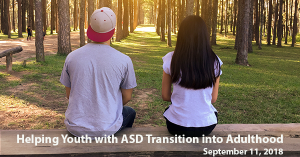
Background: Most research done to date on Autism Spectrum Disorder (ASD) has focused on individual factors and outcomes, such as the genetic basis for ASD or the effects of treatment on individuals. However, less academic attention has been given to people with ASD as a population – such as studies of the non-clinical interventions that may affect outcomes for this group.
What’s New: A recent article outlined a new research agenda, prioritizing topics for those studying ASD in the United States. These priorities stemmed from key informant interviews as well as a meeting of stakeholders representing the medical, therapeutic, educational, policy, and public health fields. Both of these processes were informed by a scoping review identifying gaps in existing research on ASD and the transition of youth into adulthood.
The stakeholders identified three main priorities for research targeting youth with ASD:
- Studies describing the existing landscape of services and programs for people with ASD, including its availability and adaptability to individual needs;
- Studies on the coordination of ASD stakeholders, including adults with ASD, their family members, and mental health organizations; and
- Studies on the quality of life of people with ASD and how it varies among people, groups, and populations.
Why it’s important: This article sets out knowledge gaps in the existing research on ASD and provides a path forward for researchers interested in helping this population. The authors also emphasize the need for increased involvement of people with ASD in informing priorities and moving the research agenda forward.
Help me understand :
| Source(s) : |
| Tweet |
Older Adults with Autism May Need Psychiatric Care
By Chelsea Toledo, M.A. on April 26, 2018
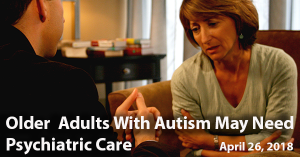
Background: While Autism Spectrum Disorder (ASD) is most often diagnosed in childhood, the disorder affects people of all ages. However, very little research has been to assess the needs of older adults with ASD.
What’s New: A recent study looked into co-occurring conditions in people over the age of 50 with ASD. The researchers examined data from more than 600 individuals who were eligible for disability services in Sweden between 2002 and 2012 – all with ASD diagnoses. They aimed to determine the rates of intellectual disability, affective disorders, mental illness, substance abuse, and pharmaceutical prescriptions in this group.
The researchers found:
- The majority of individuals in this group (57%) had no intellectual disability.
- Half of the individuals assessed had at least one psychiatric disorder, and the most commonly diagnosed were affective disorders such as bipolar.
- Most of the group (63%) had received some sort of psychiatric care.
- Individuals in this group were very likely to have been prescribed some sort of psychotropic medication – with 63% of patients with no diagnosed intellectual disability and 84% of patients with intellectual disability having been prescribed antipsychotic drugs.
Why it’s important: This study suggests that older people living with ASD have a need for psychiatric care services. Further study of this group could find explanations for the patterns in co-occuring conditions (such as higher rates of psychiatric disorders among people with Asperger’s syndrome), and guide therapeutic interventions for this vulnerable group.
Help me understand :
| Source(s) : |
| Tweet |
Children with ASD Are at Greater Risk of Sleep Problems
By Chelsea Toledo, M.A. on March 7, 2018
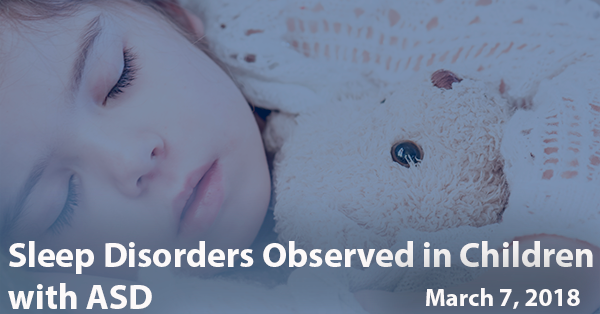
Background: Parents and caretakers of children with Autism Spectrum Disorder, or ASD, may notice disturbances in their children’s sleep. Among the many co-occurring symptoms in ASD, disturbed sleep can exacerbate existing issues with behavior and attention.
What’s New: A recent study compared sleep disturbances among children with a series of neurodevelopmental disorders. The researchers administered a known sleep questionnaire to the families of 193 children between the ages of 2 and 15 — 26 of whom had Smith-Magenis syndrome, 70 of whom had Angelman syndrome, 30 of whom had ASD, 20 of whom had tuberous sclerosis complex, and 47 of whom demonstrated typical development. The questionnaire assessed the children’s bedtime routines, sleep problems (such as waking during the night or taking more than an hour to fall asleep), and the perceived effectiveness of any attempted treatments.
The researchers found:
- Sleep problems occurred with greater frequency and consistency in the groups with neurodevelopmental disorders than in the typically developing group.
- Forty-three percent of the children with ASD experienced severe night waking problems.
- Thirty percent of the children with ASD experienced severe issues with settling down to sleep.
- Children with ASD were more likely than the other groups to experience sleep anxiety, bedtime resistance, and unusual sleep behavior — with rates of 13, 15, and 22 percent, respectively.
- Other sleep problems (including sleep-disordered breathing) were more common in the ASD group than in the typically developing group, but more common still among children with the other neurodevelopmental disorders.
- Interestingly, sleep-disordered breathing was linked to gastrointestinal symptoms in the ASD group.
Why it’s important: This study contributes to a growing body of research accounting for a holistic picture of ASD’s symptoms and possible causes. Further research could reveal syndrome-specific profiles, paving the way for targeted therapy.
Help me understand :
| Source(s) : |
| Tweet |
Robot coach for Job Seekers with ASD?
By Paras Kaul and Chelsea Toledo on December 13, 2017

Background: People with autism spectrum disorder (ASD) sometimes experience difficulty seeking employment due to differences in social and verbal skills. Early evidence suggests that leveraging robots in mock job interviews can help to train individuals with ASD for the actual experience.
What’s New: A recent study explored the possibility of leveraging artificial intelligence as a preparatory aid for job seekers with ASD. Fifteen participants between the ages of 18 and 25 with ASD completed a mock job application with questions about one of six jobs they chose to pursue. For five days they interviewed with either the robot or the human at the same time each day. Researchers measured salivary cortisol levels – a biomarker for stress and anxiety - at the same time of day after each mock interview to see if there were any changes.
After their interviews, participants received questionnaires about their performance. Responses from participants who met with the robots indicated improvements in their self-confidence with somewhat reduced levels of stress and anxiety. While cortisol levels were lower among the individuals who interviewed with a robot, the hormone spiked on Day 2 of the exercise – a possible indication of a physical reaction needed for an individual with ASD to perform.
Why it’s important: This study suggests that the stress, anxiety, and self-confidence people with ASD experience in job interviews can be reduced with training from android robots that look like humans. Training in mock job interviews with robots may be useful in addressing social and communicative challenges that prevent the ASD population from getting jobs in the real-world. This possibility – as well as the link between cortisol spikes and interview performance – merits further investigation via larger studies.
Help me understand :
| Source(s) : |
| Tweet |
Symptom Profile in Adults with Autism
By Chelsea E. Toledo, M.A. on December 7, 2017
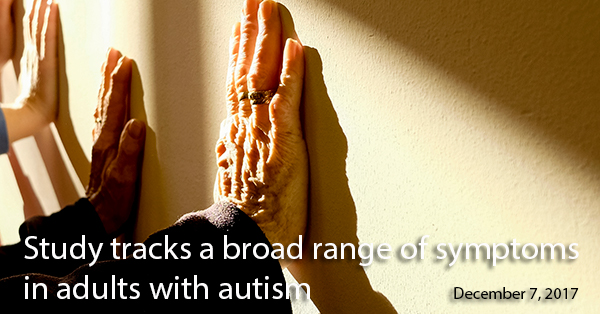
Background: With increasing prevalence of Autism Spectrum Disorder (ASD) in the past decades, a growing number of families face concerns about caring for children with ASD as they enter adulthood. One question for families and clinicians is whether the conditions that oftentimes accompany ASD – including tantrums, seizure, sleep and gastrointestinal (GI) disorders– will persist as the children age.
What’s new: A recent study tracked a number of symptoms and conditions that tend to accompany ASD in older adults over time. The retrospective study leveraged 35 years of medical records belonging to 74 adults with ASD, obtained with permission from a community agency serving this group. The researchers made several important observations:
- Behavioral and psychiatric symptoms (including self-harm and tantrums) decreased significantly across the board as the individuals aged.
- Physical symptoms differed somewhat among participants older than 50 when compared to their younger peers; the older group experienced more GI symptoms, while the younger group was more likely to experience diabetes and hay fever, and to exhibit physical aggression.
Why it’s important: This study suggests that the behavioral and psychiatric symptoms observed in children with ASD may not persist as the children get older. It also points to possible differences between middle aged and older people with ASD, which merit further study.
Help me understand :
| Source(s) : |
| Tweet |
Sleep Meds May Make Behavior Worse in Autism
By Chelsea E. Toledo, M.A. on March 8, 2016
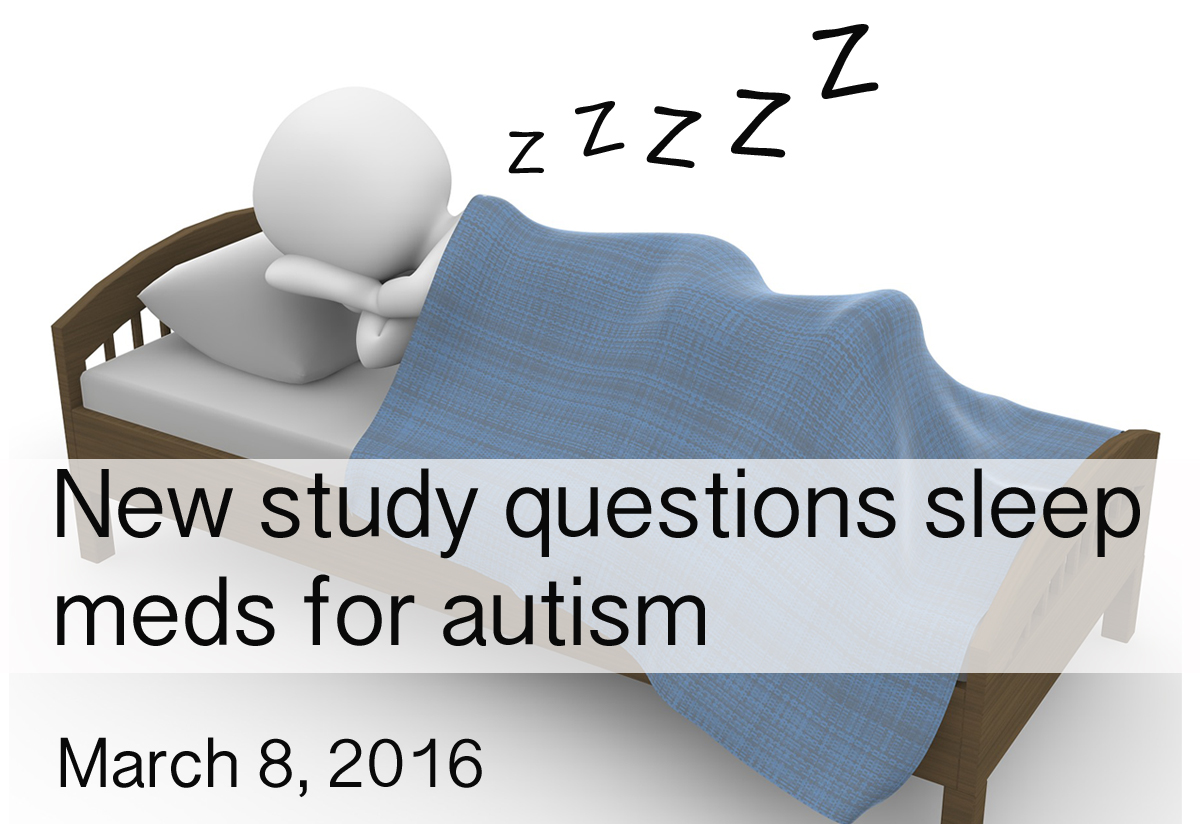
Background: Sleep disturbances are a common occurrence in children with autism spectrum disorder (ASD). Researchers have estimated that between 50 and 80 percent of people with the disorder experience difficulty sleeping.
What’s New: The February issue of Pediatrics included a study exploring the frequency of sleep difficulties and the use of sleep medications in children with autism. The researchers analyzed questionnaires from parents of 1518 children between the ages of four and ten who had been diagnosed with ASD. They found that – while only 30 percent of the children had a diagnosed sleep disorder – the scores of more than 70 percent of the children on a sleep habits questionnaire indicated significant sleep problems. In addition, the researchers found that the daytime behavior of the nearly 400 children prescribed sleep medications was reported to be worse than that of the children not taking sleep medications.
Why it’s important: This study underscores the need to screen for sleep problems during the diagnostic process for ASD. Future studies could investigate the underlying factors influencing the effects of sleep medications on this population to develop evidence-based recommendations for sleep treatments.
Help me understand :
| Source(s) : |
| Tweet |
Follow-up of symptoms associated with autism
By Shana R. Spindler, Ph.D. on January 26, 2016
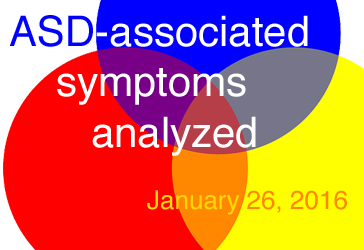
Background: Previous studies have shown that Autism Spectrum Disorder (ASD) is frequently associated with a number of health conditions in addition to the core symptoms of social communications and repetitive behavior. The rate and time course of these co-occurring symptoms, such as sleep disturbances or gastrointestinal (GI) problems, have not been fully analyzed.
What’s new: In the February 2016 issue of Research in Autism Spectrum Disorders, researchers from the National University of Ireland published a two-year follow-up study to examine co-occurring conditions in 56 children and adolescents with ASD. They found that sleep problems and GI symptoms persisted in about 91 percent and 84 percent of the participants, respectively. High rates of sleep problems co-occurred in individuals with bloating, nausea, abdominal pain, diarrhea, and/or constipation.
The researchers found that almost 93 percent of the participants had a family history of autoimmune disorders. Individuals with a history of thyroid disorders had greater GI symptoms, while a history of ulcerative colitis or Crohn’s disease associated with depressive symptoms, repetitive behavior, and sleep duration.
Why it’s important: This is the first study to investigate several comorbid conditions over two years. The results suggest a link between autoimmune disorders, GI symptoms, and sleep problems in children and adolescents with ASD, but additional research is needed to make any conclusions.
Help me understand :
| Source(s) : |
| Tweet |
Neural Basis of Noise Overload in ASD Explained
By Shana R. Spindler, PhD on November 17, 2015
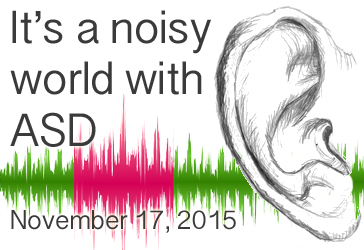
Background: About 90 percent of people with Autism Spectrum Disorder (ASD) experience some form of sensory-related symptoms, such as over or under sensitivity to sights, sounds, and even tastes (reviewed in Geschwind, 2009). Researchers have hypothesized that an abnormal adaptation to sensory stimuli may underlie the social and communication difficulties seen in ASD.
What’s new: On November 5, 2015, Scientific Reports published a study examining loudness adaptation in 20 adults with ASD and 20 neurotypical individuals. The researchers found that adults with ASD were slower and less able to adapt to a continuous, low-level sound than neurotypical adults.
In the study, the participants listened to a soft, constant sound for several minutes and recorded the perceived volume of the sound at specific time intervals. While the neurotypical individuals said the sound decreased by about 50 percent in volume over time—even though the volume of the sound was unchanged—adults with ASD perceived a mere 20 percent reduction. In contrast, adaptation to loud sounds with intermittent disruptions was similar between neurotypical adults and those with ASD.
Why it’s important: The adaptation to constant, quiet sounds is thought to involve a different part of the brain than adaptation to loud, interrupted sounds—think of the hum of a refrigerator versus a fire alarm. Therefore, this is the first study to show that noise overload in ASD may stem from a neural inability to adapt to certain sound types. Interestingly, for individuals with ASD who reported using coping strategies, their adaptive responses were closer to neurotypical individuals.
Help me understand :
| Source(s) : |
| Tweet |
How People with ASD See the World Differently
By Chelsea E. Toledo, M.A. on November 10, 2015
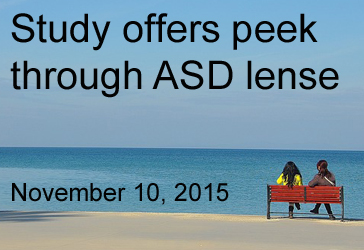
Background: Autism spectrum disorder (ASD) affects three major and inter-related areas: communication, social interaction, and behavior. Research has shown that people with the disorder read faces and other social cues differently than their typically developing peers, which could contribute to the observed behavioral symptoms in ASD.
What’s New: On November 4, 2015, the journal Neuron published a study exploring how general gaze – not just at faces – may differ in individuals with ASD. The researchers showed 700 naturalistic images capturing common daily scenarios to 20 people with ASD and average IQ. Using an eye-tracking device to follow their gaze, they found that, when compared to 19 peers with typical development, the ASD group spent more time focused on the center of an image, even if there was no object in the image’s center. They also found that the ASD group took longer to focus on faces in the images, but were quicker than their typically developing peers to focus on mechanical objects.
Why it’s important: This study suggests that differences in gaze observed in people with ASD is not limited to reading faces, but represents a larger perceptive difference. Larger studies are needed to further define these differences in atypical visual processing in ASD. The eye tracking methodology holds much promise as a non-behavioral early ASD diagnostic marker.
Help me understand :
| Source(s) : |
| Tweet |
Study Suggests Mobile App Helps Social Interaction
By Chelsea E. Toledo, M.A. on October 29, 2015

Background: Advances in mobile computing, such as iPad, hold promise as assistive or adaptive tools for individuals with autism spectrum disorder (ASD). Numerous ASD-related apps are commercially available. However, very few studies have rigorously tested their utility for improving social skills in people with the disorder.
What’s new: An upcoming issue of Association of Computing Machinery Transactions will include a study exploring the potential of a mobile app to improve social interaction in children with ASD. The researchers grouped eight children with ASD into four pairs, and alternated activities for each pair over a period of four weeks. The children had blocks to play with on weeks one and three and a two-player iPad game called Zody to play with on weeks two and four. Interviews conducted at the end of the four-week period suggested that the iPad game – which required players to take on collaborative roles – helped improve social interaction skills in the participants.
Why it’s important: This study may provide a proof of the principle that electronic assistive technologies can help improve social interactions in children with ASD. Future studies with larger participant groups could demonstrate this concept further and refine the use of specific assistive technologies.
Help me understand :
| Source(s) : |
| Tweet |
Repetition May Impair Learning in Autism, Study Finds
By Chelsea E. Toledo, M.A. on October 15, 2015

Background: Cognitive flexibility refers to the ability to shift one’s thinking in response to a change in stimuli. Studies have shown that people with autism spectrum disorder (ASD) often struggle with cognitive flexibility. For example, after successfully completing a drill of identifying an object in a picture, individuals with ASD don’t always transfer that knowledge when asked to identify the same object in another picture.
What’s New: On October, 2015, the journal Nature Neuroscience published a study exploring the roots of cognitive inflexibility as it relates to ASD. The researchers administered a test to 23 high-functioning adults with ASD and 19 typically developing controls, asking them to locate a set of diagonal bars among horizontal bars on a screen multiple times over a period of eight days, with the location of the target switching on the fifth day. The ASD group performed similarly to the control group over the first four days, but not on days five through eight. However, a second group of participants and controls underwent a similar test – only with “dummy” screens shown in between tasks – and the ASD group did not experience the same dip in performance when the target switched locations.
Why it’s important: This study suggests that, while repetition may be an effective way to teach a single concept, repeated stimuli may in fact derail longer-term learning for people with ASD. Future studies could lay the groundwork for less repetitive learning models to aid in the education of people with ASD.
Help me understand :
| Source(s) : |
| Tweet |
Repetitive Behavior Less Severe in Girls with ASD
By Shana R. Spindler, PhD on September 18, 2015
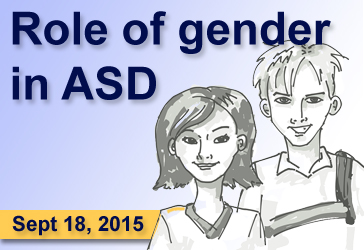
Background: The core symptoms of Autism Spectrum Disorder (ASD) include social differences, communication difficulties, and restricted or repetitive behaviors. While ASD is four times more common in boys than in girls, the cause of this gender gap is unclear. Research studies are being conducted to investigate gender differences in ASD.
What’s new: In a large study of ASD core symptom severity in boys and girls, Stanford University School of Medicine researchers report that girls with ASD have fewer repetitive behaviors than boys on the spectrum. The study, published in the journal Molecular Autism, looked at ASD symptom severity using two well-established datasets of children with ASD. In both datasets, the researchers found that girls scored better than boys on measures of restrictive and repetitive behaviors, with no difference between social and communication function reported.
Brain imaging data for 25 boys and 25 girls with ASD from one of the datasets showed differences in grey matter volume in motor-related and social brain areas. The researchers did not find the same gender differences in grey matter volume between neurotypical boys and girls.
Why it’s important: Examination of ASD core symptom severity in boys and girls may offer clues about ASD risk factors in each gender—such as brain areas sensitive to environmental or genetic stressors. The current study included children with high-functioning ASD only. Additional studies that test these findings in children from a wider range of the spectrum are needed.
Help me understand :
| Source(s) : |
| Tweet |
Sensorimotor Differences in ASD Appear in Infancy
By Chelsea E. Toledo, M.A. on August 4, 2015

Background: In the United States, one in 68 children is estimated to have Autism Spectrum Disorder (ASD). Children who have an older sibling with the disorder face a much higher risk, which studies have estimated to be about one in 10. Researchers can study these infants and toddlers at high risk of ASD to learn about the early onset characteristics of autism.
What’s New: On July 16, 2015, The Journal of Neurodevelopmental Disorders published a study exploring differences in behavioral, cognitive, and adaptive development among infants at high and low risk of developing ASD. The researchers performed established screenings to assess the behavior of 308 children—210 of whom were high-risk and 98 of whom were low risk for ASD—at 6, 12 and 24 months of age. They classified 49 of the high-risk children as having ASD at 24 months, with the children who most closely matched the profile demonstrating sensorimotor deficits at 6 months of age. In contrast, the less severely affected children displayed their first differences in the form of socio-communication skills by two years of age.
Why it’s important: Previous studies on infants have revealed differences first appearing in social and communicative abilities. This finding—that children most severely affected by ASD have early sensorimotor difficulties—could reveal some of the physiological basis for the disorder, leading to earlier diagnosis and intervention.
Help me understand :
| Source(s) : |
| Tweet |
Study Questions Gluten- and Casein-Free Diets for ASD
By Chelsea E. Toledo, M.A. on July 23, 2015
Background: Autism Spectrum Disorder (ASD) has been linked to gastrointestinal issues, and some families follow specific dietary guidelines to allay both digestive and behavioral symptoms. In particular, these diets have excluded gluten and casein—proteins found in bread and milk, respectively. While some healthcare professionals recommend a gluten-free, casein-free diet—commonly known as a GFCF diet—studies that confirm its efficacy are lacking.
What’s New: On July 4, 2015, the journal Acta Paediatrica published a study exploring the effects of gluten and casein on the gastrointestinal and behavioral symptoms of children with ASD as well as the urine concentration of a protein previously associated with behavioral issues in autistic children. The researchers performed a double-blind, randomized clinical study on children between the ages of 4 and 7 with severe behavioral issues related to ASD, all of whom were already on a gluten- and casein-free diet. After giving a gluten-casein supplement to 38 children and a rice meal placebo to 36 children for one week, they found no significant difference between the two groups in behavior, urinary protein expression, and level of gastrointestinal disruption.
Why it’s important: While previous studies have evaluated the effects of eliminating gluten and casein from the diets of children with ASD, this is the first study to explore the results of adding the proteins back in. Future studies could evaluate the long-term effects of gluten and casein on behavior and gastrointestinal symptoms, given the limited exposure time to these proteins in this study.
Help me understand :
| Source(s) : |
| Tweet |
Study Probes Memory and Language Patterns in ASD
By Chelsea E. Toledo, M.A. on July 7, 2015
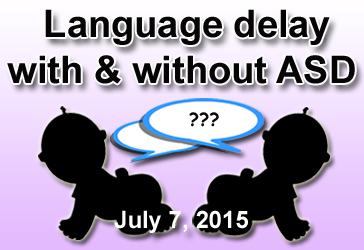
Background: While differences in communication comprise a core feature of autism spectrum disorder (ASD), those with the disorder experience a wide range of language abilities and impairments. Studies have compared language delay in children with ASD to language delay in those without the disorder—demonstrating an overlap in the difficulties they encounter producing sounds, words, and language.
What’s New: On June 14, 2015, the Journal of Neurodevelopmental Disorders published a study assessing language impairment in children with and without ASD. The researchers administered a battery of language tests to 60 children between 5 and 8 years of age. They found that children who experienced language impairments (both with and without ASD) had more trouble remembering words that they had heard than children with ASD and no language impairment. However, the ability to repeat non-word sounds differed among children with language delay—those with ASD outperformed those without ASD in repeating short non-word sounds.
Why it’s important: This study suggests that the neurodevelopmental factors leading to language delay in children with ASD are different from those leading to impairments in children without the disorder. Long-term studies of both populations could shed light on how patterns in their language and memory compare as they mature.
Help me understand :
| Source(s) : |
| Tweet |
Lifetime Financial Cost of Autism in Millions
By Shana R. Spindler, Ph.D. on June 10, 2014
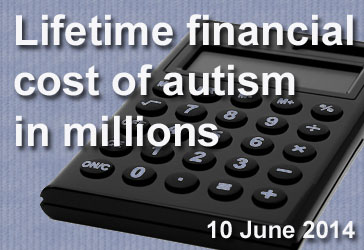
Background: The financial cost associated with autism therapy, lost time at work, and medical bills are significant. One study quantified this cost.
What's new: The lifetime cost of supporting someone with Autism Spectrum Disorder (ASD) ranges from 1.4 to over 2 million dollars, according to a new study by United States and United Kingdom researchers. The team reviewed online research literature using keywords associated with autism and financial costs. Special education programs and parental productivity loss contributed the most to cost during childhood, while supported living accommodations and individual productivity loss contributed to high costs during adulthood.
Why it's important: The study highlights the critical need for cost-effective interventions and policies that take into account the financial impact of ASD on families.
Help me understand :
| Source(s) : |
| Tweet |
Children with ASD Have Greater Visual Focus
By Chelsea E. Toledo, M.A. on June 6, 2014
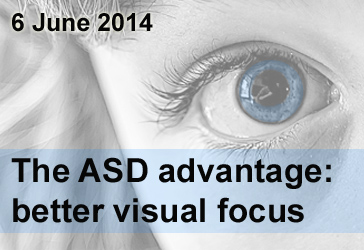
Background: Autism Spectrum Disorder (ASD) is characterized by atypical communication, social skills, and behaviors. While much research has focused on deficits in speech and social learning, few studies have focused on areas where children with ASD outperform their peers—namely, in the performance of many visual tasks requiring sustained attention.
What’s New: On March 7, 2014, the journal Scientific Reports published a study comparing the visual capabilities of autistic children and their typically developing peers. The researchers—who had previously shown that toddlers with ASD scored better on visual search tasks—measured pupil dilation in 34 children between the ages of one and three years as they viewed pictures and animations containing a distinct target. For example, the children were encouraged to locate a red apple in an image that also contained blue apples and other red shapes. Pupil dilation in the 17 children with ASD indicated that, while they searched similarly to their peers, their focus was much more intense.
Why it’s important: For the first time, pupillometry, a sensitive measure of task-based pupil responses, is used to evaluate superior visual performance in children with ASD compared to typically developing controls.The differences observed in the two groups indicate different activity levels of the locus coeruleus-norepinephrine (LC-NE) system, part of the brain underlying the regulation of attention. This study lends support to the idea that individuals with ASD could perform better on tasks requiring undistracted focus compared to tasks requiring rapid shifts in attention.
Help me understand :
| Source(s) : |
| Tweet |
Researchers Report Promising New Sensory Test For ASD
By Shana R. Spindler, Ph.D. on May 25, 2014
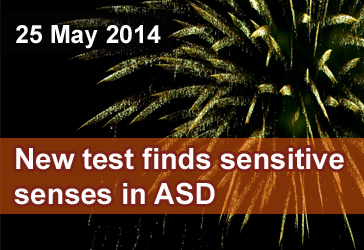
Background: The new edition of the Diagnostic and Statistical Manual of Mental Disorders (DSM-5) includes sensory sensitivity as a core feature of Autism Spectrum Disorder (ASD). Those with ASD may be extra responsive to changes in temperature, loud noises, strong smells and tastes, or even bright colors. Most sensory questionnaires targeted to individuals with autism are parental reports. Few sensory questionnaires exist for self-reporting by adults with ASD.
What’s new: A new questionnaire, called the Sensory Perception Quotient (SPQ), can reliably measure sensory sensitivity in adults with and without ASD, according to a new study published in Molecular Autism. The SPQ contains statements meant to identify a person’s sensitivity to surrounding sensory inputs, such as “I would be able to detect if a strawberry was ripe by smell alone,” or “I can hear electricity humming in the walls.” The test taker then agrees or disagrees with the statement on a scale of 0 (strongly agrees) to 3 (strongly disagrees). After giving the SPQ to 196 adults with ASD and 163 control participants, the researchers verified that adults with ASD are significantly more sensitive than controls to sight, sound, touch, and taste, but not smell.
Why it’s important: Previous sensory tests for adults assessed behavioral response to the environment rather than focusing on how intensely a person senses surrounding stimuli. While additional research is needed to determine if results from the SPQ match laboratory-measured sensitivity, the SPQ is a promising new tool for identify the sensory needs of individuals in the autism community.
Help me understand :
| Source(s) : |
| Tweet |
Researchers Explore ASD and GI Symptoms Link
By Chelsea E. Toledo, M.A. on May 8, 2014
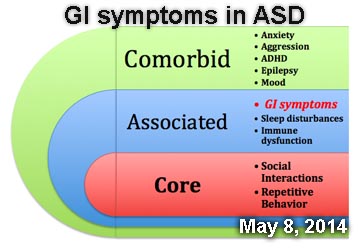
Background: For over thirty years, researchers have suspected a link between Autism Spectrum Disorder (ASD) and gastrointestinal (GI) symptoms. The GI symptoms frequently reported in ASD include abdominal pain, constipation, chronic diarrhea, and gastroesophageal reflux disease. Recently, The National Institutes of Health has prioritized research exploring GI symptoms in people with ASD.
What’s new: On May 2, 2014, the journal Pediatrics published a meta-analysis of GI symptoms in ASD, examining 15 studies conducted between 1980 and 2012. In all, the analysis included data from 2215 children with ASD, whose GI indicators were compared to those in children without ASD. The researchers found that, when all studies were taken into consideration, children with ASD were much more likely than their typically developing counterparts to experience general GI symptoms—as well as specific symptoms such as diarrhea, constipation, and abdominal pain.
Why it’s important: This study is the first thorough evaluation of the evidence suggesting that GI dysfunction is more common in children with ASD. More research is needed to determine why GI symptoms appear more common in people with ASD, as well as their long-term effects.
Help me understand :
| Source(s) : |
| Tweet |
Soy-Based Infant Formula Doubles Risk of Seizures
By Shana R. Spindler, Ph.D. on April 22, 2014
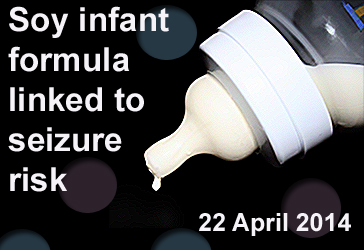
Background: Nearly 25 percent of infant formulas use soy protein, and many families rely on this non-dairy alternative during an infant’s first years of life. Some are concerned, however, that a component in soy called phytoestrogens may have an adverse impact on infants’ health by mimicking hormones in the body. Given the widespread use of soy-based formula, relatively few studies have addressed the effect of phytoestrogens on early childhood development.
What’s new: In 2013, Dr. Cara J. Westmark of the University of Wisconsin, Madison, reported that mice with neurological disease had more seizures while eating a soy-based diet. Now, she has expanded her studies to a human population. In the March 2014 issue of the online journal Plos One, Dr. Westmark reports that children with Autism Spectrum Disorder (ASD) are 2.6 times more likely to have febrile seizures—those associated with a high fever—and 2.1 times more likely to have epilepsy when given a soy-based infant formula. Even though the study was large, including 1,949 children, caution should be taken before making firm conclusions. The formula and seizure data were based on parental recall, and the study did not take into account the reasons for using soy formula nor the length of time on it.
Why it’s important: This study highlights the need to further investigate an association between phytoestrogen exposure early in life and an increased risk of seizures in the ASD population. The ability to decrease seizure risk through diet modification alone would be an important finding for those with ASD.
Help me understand :
| Source(s) : |
| Tweet |
Empathy For Others in Pain Present in ASD
By Shana R. Spindler, Ph.D. on January 23, 2014
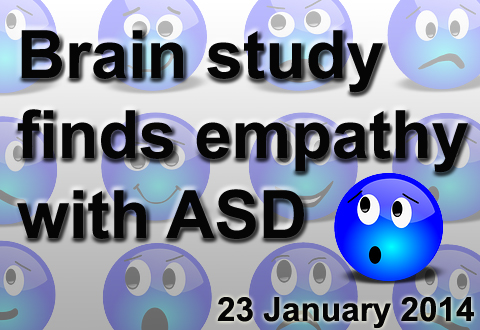
Background: Empathy is the ability to understand what another person is feeling. The lack of this trait was thought to underlie some of the social problems present in people with Autism Spectrum Disorder (ASD). However, few studies have addressed the brain activity of those with ASD in situations where empathy would be likely.
What’s new: On January 14, 2014, the online journal Translational Psychiatry published a study that suggests people with ASD maintain the neural ability to process empathy, at least when seeing others in pain. Researchers used functional magnetic resonance imaging to examine the spontaneous brain activity of 38 adolescents and adults with high-functioning ASD and 35 age-matched controls as they watched two-second videos of people with shoulder pain.
Contrary to popular belief, the individuals with ASD showed no significant difference in spontaneous brain activity upon seeing someone in pain as compared to the control group. Both groups had activity in brain areas involving emotional arousal and understanding. At a lower statistical threshold, the group with ASD appeared to have increased activity in brain areas likely used for situation assessment.
Why it’s important: The researchers suggest that empathy remains intact in ASD, while the perceived lack of caring links to attempts to calm personal distress by reassessing the situation. The authors of the study note that pain is a very basic social cue and that future studies should look at additional situations where empathy is used.
Help me understand :
| Source(s) : |
| Tweet |
Multi-Year Study Follows Sleep Difficulties in ASD
By Shana R. Spindler, Ph.D. on December 18, 2013
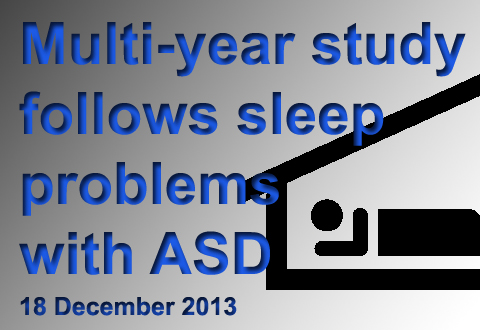
Background: According to several studies, children with Autism Spectrum Disorder (ASD) are more likely to have sleep problems than typically developing children. These include reduced sleep, night waking, early morning waking, nightmares, and the lack of a sleep routine. It is important to understand sleep difficulties in ASD as they can negatively affect daytime behavior.
What’s new: In a study that followed over 10,000 English children for 11 years, researchers from the UK and Canada recorded sleep patterns of children from six to 140 months of age. Of those children, 73 were eventually diagnosed with ASD. Children with ASD slept on average 43 minutes less than typical children at 81 months of age. The decreased sleep times began around 30 to 42 months of age and lasted until adolescence.
Why it’s important: This study highlights the need for parents to evaluate sleep problems in children with ASD from an early age. If sleep problems persist, parents can discuss therapeutic options with their doctor.
Help me understand :
| Source(s) : |
| Tweet |
Parent Training May Improve Autistic Children’s Diet
By Chelsea E. Toledo, M.A. on October 18, 2013
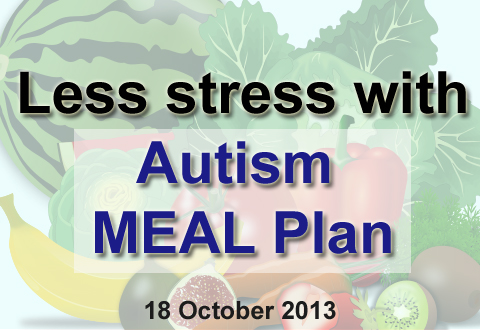
Background: Anecdotal evidence demonstrates that children with Autism Spectrum Disorder (ASD) often have problems maintaining a regular diet, and studies suggest that this population is at a greater risk for nutritional issues—including vitamin deficiencies, poor bone growth, and obesity.
What’s New: On October 7, 2013, the journal Autism published a pilot study evaluating a curriculum for parents to address feeding issues in children with ASD. The program, called the Autism MEAL Plan, was administered over eight training sessions and covered behavior management strategies, specific interventions for ASD-associated feeding issues, and tactics to promote self-feeding. 30 families began the study, completing a series of evaluations to assess dietary issues, general health, and stress experience by parents. Of the 19 families continuing on with the study, 10 completed Autism MEAL Plan training, reporting a significant reduction in parental stress as compared to the control group. However, no significant differences between groups existed regarding feeding behaviors and dietary variety following the intervention.
Why it’s important: This study provides preliminary evidence to support parental training programs for the sake of improving meal time for children with ASD. However, because so few families participated, further research is needed to provide conclusive results.
Help me understand :
| Source(s) : |
| Tweet |
Study Examines Behavior in Older Adults with ASD
By Chelsea E. Toledo, M.A. on October 4, 2013
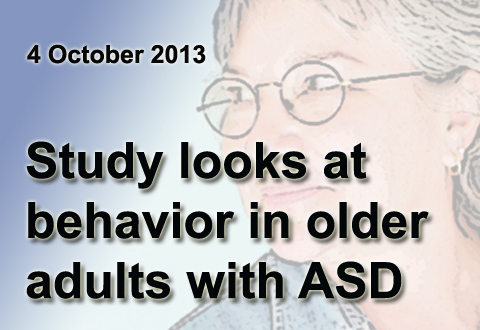
Background: Autism spectrum disorder (ASD) has been studied extensively in children, and is now estimated to affect one in every 88. However, relatively few have examined adults with the condition.
What’s New: On September 25, 2013, a study was published in the Journal of Neurodevelopmental Disorders evaluating the prevalence of clinical problems in older adults with both ASD and intellectual disabilities. Using surveys administered across states between 2009 and 2011, the researchers evaluated more than 10,000 cases of intellectual disability in adults between the ages of 30 and 59. They found that about 8 percent of study participants had ASD, and that those with both ASD and intellectual disabilities were about twice as likely—at about 50 percent—to engage in self-harm, disruptive, and destructive behaviors than their counterparts without ASD.
Why it’s important: This study demonstrates the need for more research focusing on adults with ASD, whose population is increasing.
Help me understand :
| Source(s) : |
| Tweet |
Age and IQ Are Predictors of Epilepsy Risk in ASD
By Shana R. Spindler, Ph.D. on September 27, 2013

Background: Many children with Autism Spectrum Disorder (ASD) also have random, recurrent seizures, called epilepsy. According to previous research, children with ASD are at higher risk for epilepsy than the general population, with studies reporting epileptic seizures in four to 48 percent of people with ASD. Few studies have been large enough, however, to determine if specific traits, such as IQ, age, or gender, associate with an increased epilepsy risk.
What’s new: The online journal PLOS ONE published a study that looked at epilepsy rates in four samples of children with ASD, totaling 5,815 participants. In the general population sample, the researchers found that 12 percent of children with ASD also had epilepsy. But that percentage increased to 26 percent by adolescence. When the researchers examined cognitive ability, they found that individuals with a lower intelligence quotient (IQ) were more likely to have epilepsy. They also examined gender, language ability, and developmental regression, but upon controlling for IQ, these traits were not significant predictors of epilepsy. Therefore, the researchers suggest that age and low IQ are among the strongest epilepsy risk factors.
Why it’s important: This is one of the largest studies to look at factors involved in the development of epilepsy with ASD. Knowing epilepsy risk factors can help clinicians make an informed prognosis and provide guidelines for patients who are at high risk for epilepsy. Individuals who have or are at risk for epilepsy may require specialized medical care.
Help me understand :
| Source(s) : |
| Tweet |
Autism Linked to Differences in Gut Microbes
By Chelsea E. Toledo, M.A. on July 10, 2013

Background: Inside the human gut, communities of benign microbes thrive, aiding in digestion. Studies have demonstrated that gastrointestinal (GI) issues often arise in people with autism spectrum disorder (ASD), but very few have examined how variability in so-called “good bacteria” in the gut might contribute to that trend.
What’s New: On July 3, 2013, the online journal PLOS ONE featured a study examining systematic changes in gut microbes as they related to ASD and accompanying GI problems. The researchers administered a survey to 40 children between the ages of three and 16 to assess symptoms of GI issues and ASD. They then took fecal DNA samples, which revealed that the children who had reported ASD symptoms had less diversity in their gut microbes than their typically developing counterparts, with significant and systematic reduction of certain carbohydrate-degrading and/or fermenting bacteria.
Why it’s important: This study demonstrated that the presence of ASD symptoms—as opposed to the symptoms of GI problems—was linked to specific irregularities in gut microbe composition. The finding could inform future research to diagnose and formulate dietary interventions for treating ASD.
Help me understand :
| Source(s) : |
| Tweet |
Overlapping Disorders Can Inform Autism Symptoms
By Chelsea E. Toledo, M.A. on June 6, 2013
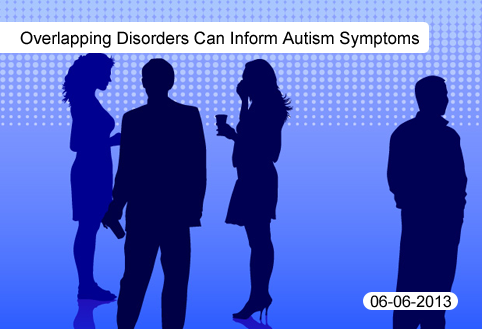
Background: In clinical settings, health professionals have noted overlaps between autism spectrum disorder (ASD) and various other childhood syndromes, such as attention deficit hyperactivity disorder (ADHD). A leading child psychiatrist, Christopher Gillberg, proposed a model in 2010—called Early Symptomatic Syndromes Eliciting Neurodevelopmental Clinical Examinations (ESSENCE)—in which a range of disorders affecting childhood development would be considered and addressed simultaneously.
What’s New: On March 25, 2013, the Scientific World Journal published a retrospective study of 413 adults with various psychiatric disorders. Their parents reported the impairments they faced in early development—including difficulties in communication, motor skills, social interaction, and other areas. As children, individuals with either ASD or ADHD, or both disorders, reportedly faced greater difficulties in nearly all areas than those with other disorders.
Why it’s important: This study suggests that developmental disorders like ADHD and ASD are linked to a range of problems with behavior and development. Using the ESSENCE model, the researchers identified symptoms that professionals do not use to diagnose ASD or ADHD, such as gross and fine motor skills, body and visual perception, memory, and time concepts, to name a few, but that can nevertheless shed light on the complexity those disorders present.
Help me understand :
| Source(s) : |
| Tweet |
Study Supports Need for School-Age Resources
By Mark N. Ziats on May 2, 2013

Background: Previous research has shown that children with Autism Spectrum Disorders (ASD) have deficits in executive functioning, such as poor impulse control, problems maintaining working memory, and difficulty quickly shifting between tasks. Studies of executive functioning in children with ASD have typically been conducted in artificial laboratory settings and fail to follow children over the course of their development. The real-world pattern and development of executive function deficits in children with ASD remains unclear.
What’s new: A recent study published in the January 2013 issue of the journal Neuropsychology investigates executive function in children with ASD at home and across a broad developmental period spanning 5 to 18 years of age. The authors report that executive functioning impairments increase as children with ASD age, as compared to neurotypical children, according to data collected from parental reports on 185 children with ASD. This was most profound in “metacognitive” abilities, such as following multistep directions, keeping school materials organized, and exhibiting self-motivational behavior.
Why it’s important: According to this study, children with ASD have increasing difficulty in working memory, initiation, and organization as they develop to ages where they are entering school and obtaining jobs. These situations likely exacerbate these impairments, making continuing executive function intervention and support critical during these periods. Awareness of this problem is particularly relevant in this age group because school and clinical resources are often not as accessible to children with ASD at these ages.
Help me understand :
| Source(s) : |
| Tweet |
JobTIPS Improves Interview Skills for Teens with Autism
By Mark N. Ziats on March 27, 2013
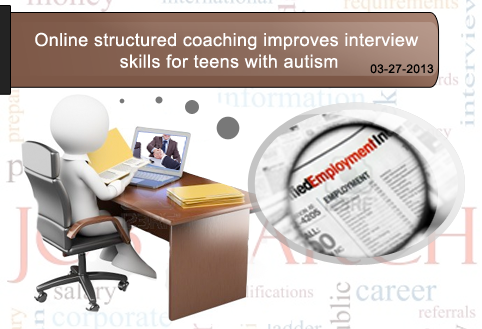
Background: Prior research has shown that individuals with autism spectrum disorder (ASD) have more difficulty gaining employment than adults with other disabilities. Deficits in social communication skills, which are important in the initial job interview process, are thought to contribute to job-related problems among individuals with high functioning ASD.
What’s new: In a new study published in the 15 March 2013 issue of the Journal of Autism and Developmental Disorders, researchers evaluated the effectiveness of a program designed to teach individuals with high functioning ASD better job interview skills. The program, called JobTIPS, is an internet-accessed platform containing videos, virtual reality practice sessions, and other tools tailored specifically to people with high functioning ASD.
In their study, the authors assessed the effectiveness of JobTIPS among twenty-two subjects with high functioning ASD, aged 16-19, by evaluating their performance in two separate simulated employment interviews per subject. After the first round of interviews, half the subjects undertook the JobTIPS training while the others did not. Using an independent board of performance reviewers, the authors concluded that subjects who completed the JobTIPS program improved their verbal content skills significantly during the second interview.
Why it’s important: This study suggests that online structured coaching can improve skills needed to obtain employment among youth with ASD. A virtual program may allow easier and more cost-effective access to these types of services. The JobTIPS website can be accessed at http://do2learn.com/JobTIPS.
Help me understand :
| Source(s) : |
| Tweet |
Resource List for Cognitive and Motor Issues in Autism
By Shana R. Spindler, PhD on March 7, 2013
News Brief: Children with autism spectrum disorder (ASD) often exhibit cognitive motor impairment and difficulty with sensory processing. While some therapy programs address motor and cognitive issues separately, several organizations are now attempting to treat cognitive and motor difficulties simultaneously in children with ASD, according to a recent commentary in Frontiers in Integrative Neuroscience. These organizations include, but are not limited to, the following:
- Bodyspeaks (https://sites.google.com/site/bodyspeaks/home)
- Helping Autism through Learning and Outreach (HALO; www.halo-soma.org)
- The Institute on Communication and Inclusion (ICI; http:// ici.syr.edu)
- Neurologic Music Therapy Services of Arizona (NMTSA; http://www.nmtsa.org/)
- Therapy Intensive Programs (TIP; www.kriscamp.org)
- Whittier Area Parents’ Association for the Developmentally Handicapped (WAPADH; http://www.wapadh.org/)
Help me understand :
| Source(s) : |
| Tweet |
Grant Will Help Study Employment Programs in Virginia
By Shana R. Spindler, PhD on January 31, 2013
News Brief: Virginia Commonwealth University (VCU), the Virginia Department for Aging and Rehabilitative Services, and Henrico County Public Schools received a federally funded, five-year, .5 million grant to boost research on how to help young adults with autism enter the workforce upon graduation from high school.
According to VCU, close to 90 percent of young adults with autism are unemployed. The Virginia-based groups found success with a nine-month internship program for young adults with autism. Through the internship, nearly 88 percent of the program’s participants secured competitive employment. The groups hope to use the grant to explore their internship model with larger numbers of autistic youth and to determine if the internships can improve social and cognitive behaviors.
Help me understand :
| Source(s) : |
| Tweet |
Study Explores How Autistic Children View Friendship
By Stacy W. Kish on December 20, 2012
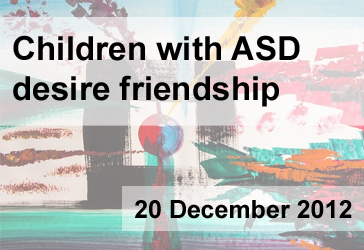
Background: Autism Spectrum Disorder (ASD) is characterized by impaired social and communication skills. Many programs now aim to improve socialization of autistic children. However, few studies examine an autistic child’s perspective.
What’s new: Researchers at the University of London investigated how autistic children experience friendships with cognitively able children in a mainstream setting. The team evaluated friendship from the child’s perspective, from the parent’s perspective, and from the teacher’s perspective.
The results from this study suggests that autistic children desire social relationships, but that autistic children define friendship in terms of companionship rather than emotional bonding. Importantly, the degree and nature of friendships did not correlate with cognitive abilities in the autistic children.
Parents and other family members played a significant role in the development of friendships by helping the autistic child engage effectively in social settings. Teachers reported that structured games with rules during lunch and playtime proved an effective mechanism to include autistic children in the class setting.
Why it’s important: Even though teachers felt that autistic children still resided on the periphery of friendship circles despite intervening efforts, the majority of autistic children reported satisfaction with their friendships. The study suggests that intervention methods to support friendship may be more successful when taking the individual child’s views and perspectives into account.
Help me understand :
| Source(s) : |
| Tweet |
Inclusive Preschools May Improve Autism Outcomes
By Chelsea E. Toledo, M.A. on December 13, 2012
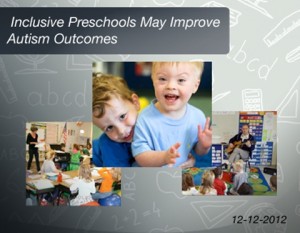
Background: Since 1990, the Individuals with Disabilities Education Act has required that states provide appropriate early intervention and special education to children with disabilities. However, little research has investigated what type of preschool placements are best for children with Autism Spectrum Disorder (ASD).
What’s New: A study published in the journal Autism investigated the differences in outcomes when autistic children were placed in preschools serving only children with ASD, in preschools educating children with a variety of disabilities, or in preschools including children with ASD alongside those with typical development. While the 98 children studied were similar based on demographics and level of initial impairment, the 36 who attended inclusive preschools--where they learned alongside children with typical development--showed greater improvement on cognitive test scores than those attending non-inclusive preschools.
Why it’s important: Among those children attending inclusive preschools, those with the most severe social and behavioral deficits but at least baseline communicative skills experienced the greatest improvement. Further research could help define which preschool placements are most appropriate for children across the autism spectrum.
Help me understand :
| Source(s) : |
| Tweet |
ER Use for Psychiatric Problems High in ASD
By Mark N. Ziats on December 12, 2012
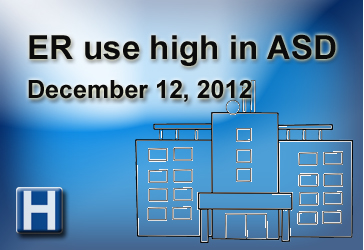
Background: Children with Autism Spectrum Disorders (ASD) have a high incidence of other psychiatric problems like anxiety, mood disorders, or psychosis. These children often have difficulty accessing proper psychiatric care in the community, and as a result may utilize hospital Emergency Rooms (ER) for their psychiatric complaints. However, the frequency and nature of psychiatric ER visits among children with ASD is unknown.
What’s new: A new study published in the journal Pediatric Emergency Care examined the prevalence and characteristics of psychiatry-related visits among children with ASD using data obtained from a national registry of ER visits. The authors discovered that psychiatry-related ER visits from children with ASD were nine times more frequent than visits from children without ASD. These visits were most commonly for externalizing and psychotic disorders. In contrast, children with ASD were less likely to present to ERs with mood and anxiety disorders than other children were. Additionally, the authors found that ER use for psychiatric problems was more common among children with ASD who had private health insurance, as compared to children with ASD using public assistance programs.
Why it’s important: This study suggests that better community psychiatric care is needed for children with ASD. Furthermore, increased education of Emergency Room staff on autisms’ clinical manifestations may improve the outcomes of these visits. Lastly, a further assessment of the influence of insurance benefits on psychiatric care usage among children with ASD is important to develop more targeted outpatient psychiatric care.
Help me understand :
| Source(s) : |
| Tweet |
Parental Stress Linked to Behavioral Problems
By Mark N. Ziats on November 28, 2012
Background: Parents of children with Autism Spectrum Disorder (ASD) have high stress levels and an increased risk for psychological problems like depression and anxiety, likely due to the daily stressors associated with parenting a child with ASD. However, little is known about stress contributors among parents who have very young children with ASD.
What’s new: A recent study published in the journal Brain and Development studied stress among parents with very young autistic children (18 – 30 months). Ninety-six parents with children who had ASD, developmental delay, or normal development completed self-report questionnaires that measured parental stress and psychological distress. Additionally, the parents completed surveys assessing their child’s behavior patterns and daily living skills.
The results showed that mothers of young children with ASD had significantly higher stress than other mothers, but no difference in psychological distress. According to the study, a mother’s stress is more linked to a child’s behavioral problems, rather than daily living skills, at this age group. This association held true for parents raising young children with autism as well as those caring for children with developmental delay.
Why it’s important: Parental stress is significant in mothers of children with ASD, and this research shows that stress is prevalent even when the child is a toddler. This study suggests that strategies to manage and reduce behavioral problems in young children with ASD may help decrease parental stress.
Help me understand :
| Source(s) : |
| Tweet |
Evidence for Impaired Social Learning in Autism
By Wayne Pereanu on October 12, 2012
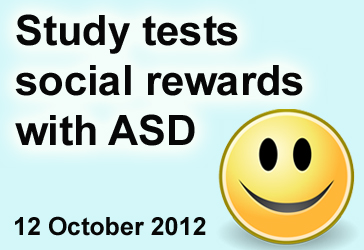
Background:
People learn how to behave in situations by associating their behaviors with rewards they receive when they are successful. Rewards can be external, like money or food, but can also be a pleasurable sensation produced by the brain. It is thought that humans learn to socially interact by being “rewarded” with pleasure during positive social encounters. A long-held theory suggests that ASD may be caused by impairments that reduce this pleasurable reward, leading to difficulty in acquiring social skills. It is currently unclear whether the reward processing deficiency is specifically impaired during only social situations.
What's new:
Researchers looked at the brain activity of 21 ASD patients using a technique known as fMRI. They asked ASD and control patients to perform tasks in which they could earn either monetary rewards (images of a coin) or social rewards (images of a happy face). They found that the ASD group had a significantly reduced response when given a social reward compared to the control group. However, no difference was found when monetary rewards were provided.
Why it's important:
The study provides direct evidence for a brain-based impairment in the “reward” system specific to social situations. Because social reward processing occurs in a distinct area of the brain, these results suggest potential areas of the brain where future work may focus.
Help me understand :
| Source(s) : |
| Tweet |
Wandering is Common and Dangerous in Autistic Children
By Mark N. Ziats on October 11, 2012
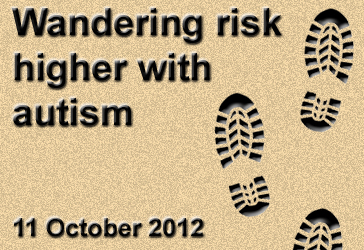
Background: Anecdotal reports from parents with autistic children have suggested that wandering away from caregivers is a serious and potentially dangerous problem. However, no study has systematically assessed this issue in a large number of patients.
What’s new: Using an online questionnaire of more than 1200 families with an autistic child, researchers discovered that almost half of autistic children had wandered away from home, and of those who wandered, half were gone for a long enough period to cause serious concern. This was significantly higher than their siblings without autism. Moreover, the autistic children were often in serious danger of drowning or traffic injury when they wandered off. Greater severity of autism was associated with a higher chance of wandering behavior.
Why it’s important: This study provides the first rigorous assessment of this problem, allowing further studies to focus on effective means of preventing, intervening, and helping parents to cope with wandering behavior. It also serves to highlight the importance of this problem for childcare professionals, teachers, and others who may be involved with autistic children.
Help me understand :
| Source(s) : |
| Tweet |
Conditions Associated with Autism
By Stacy W. Kish on September 12, 2012
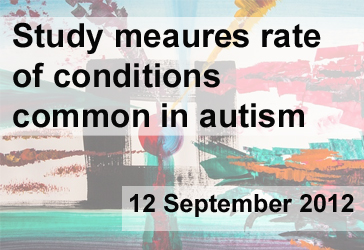
Background: Co-morbidity describes a series of conditions that are associated with an initial diagnosis. In the case of autism spectrum disorder (ASD), these conditions include sleep disorders, gastrointestinal complaints, epilepsy, cranial anomalies, muscular dystrophies, and other mental disorders. A recent study by Kohane and colleagues (2012) examined these conditions in children and young adults with ASD.
What’s new: The diagnoses of ASD has increased during the past 30 years, but most studies of co-morbid symptoms only include 200 or less patients. This study examined co-morbid condition in more than 14,000 individuals 35 years of age or younger.
The research team identified the prevalence of the following conditions in ASD individuals: epilepsy (19.4%), head anomalies (12.4%), bowel disorders (11.7%), schizophrenia (2.4%), sleeping disorders (1.1%), Down syndrome (0.9%), tuberous sclerosis (0.8%), inflammatory bowel disease (IBD) (0.8%), autoimmune disorders (DM1) (0.7%), and fragile X syndrome (0.5%). Only three of the conditions, schizophrenia, IBD, and DM1, increased with age of individuals in this study.
Why it’s important: Parents and health care professionals can use this information to better understand co-morbid conditions associated with ASD and watch for treatable symptoms.
Help me understand :
| Source(s) : |
| Tweet |
Poor Transitions for High School Graduates with Autism
By Catherine Croft Swanwick, Ph.D. on May 14, 2012
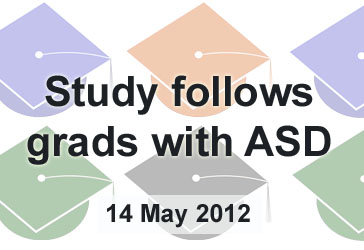
Background: Youth diagnosed with Autism Spectrum Disorders (ASD) are at high risk for unemployment and lack of post secondary education, according to a national study published recently in the journal Pediatrics. In the largest study of its kind yet, scientists analyzed outcomes for ASD youth using data generated from the National Longitudinal Transition Study 2 (NLTS2), a 10-year prospective study of youth receiving special education services conducted by SRI International for the U.S. Department of Education.
What’s New: In the six years immediately following high school, only 34.7% of youth with ASD had attended college and merely 55.1% had held paid employment. ASD youth with higher functional ability showed better outcomes, as did those from higher income families. However, overall the ASD youth exhibited significantly lower percentages than youth with other special needs, such as speech/language impairment (51.0% college, 86.0% employment), learning disability (39.9% college, 93.8% employment), or mental retardation (18.2% college, 68.9% employment).
Why It’s Important: What could be causing these poor outcomes? Signs point to problems with the transitional period after high school. In the first two years following high school, more than half of ASD youth (51.9%) were unemployed and not enrolled in college, whereas this percentage lowered dramatically to 11.1% when ASD youth had exited school at least four years ago. Together, this study recommends improved transition planning for ASD youth before they graduate from high school.
Help me understand :
| Source(s) : |
| Tweet |
Time Magazine Interviews Aspergirls Author
By Shana R. Spindler, Ph.D. on January 9, 2012
Pop News Brief: On December 27, 2011, Time Magazine published an interview with Rudy Simone, author of Aspergirls: Empowering Females with Asperger Syndrome. Simone is a San Francisco singer, writer, and comic who discovered that she had Asperger syndrome in her mid-40s. She wrote Aspergirls after finding a lack of resources for girls and women on the autism spectrum.
Help me understand :
| Source(s) : |
| Tweet |
Practice Flights for Kids with Autism
By Shana R. Spindler, Ph.D. on January 5, 2012
Pop News Brief: For families and children with autism, traveling by way of the airport can be daunting and overwhelming. NPR correspondent, Maiken Scott, writes about how the Philadelphia International Airport hosts a program that helps families and children with autism learn how to navigate air travel. In the program, families spend a day at the airport, where they practice obtaining tickets, going through security, walking to the plane, and yes, even boarding the aircraft—airplane snacks included.
Help me understand :
| Source(s) : |
| Tweet |
LA Times Discusses Modern Autism Issues
By Shana R. Spindler, Ph.D. on December 26, 2011
Pop News Brief: Between 11 December and 16 December, the Los Angeles Times published a four-part series discussing today’s controversial topics in autism. Alan Zarembo, LA Times staff writer, explores modern issues, such as the increased rate of autism diagnosis, the demographic-based struggles to ensure early intervention and therapy, the benefits and limitations of applied behavioral analysis (ABA), and the realities associated with a diagnosis of autism during adulthood. The articles are paired with a sidebar containing video vignettes of patients and families with autism, an interactive checklist for diagnosis, a map showing autism rates in the Unites States, and a timeline highlighting key historical moments in autism diagnosis and research.
Help me understand :
| Source(s) : |
| Tweet |
Autism Has Its Advantages, Says Scientist
By Shana R. Spindler, Ph.D. on November 21, 2011
Pop News Brief: Dr. Laurent Mottron, a scientist at the University of Montreal, argues in a special autism-focused November 3 issue of the journal Nature that certain characteristics associated with autism should be considered advantages rather than impairments. For example, Mottron employs individuals with autism in his own lab, where he finds their unique abilities such as “finding patterns in a distracting environment” a benefit. Mottron suggests that individuals with autism should be given opportunities that utilize their unique skill sets as opposed to behavioral therapies that attempt to alter non-harmful behavioral patterns.
Help me understand :
| Source(s) : |
| Tweet |
New York Insurers to Cover Costs
By Shana R. Spindler, Ph.D. on November 17, 2011
Pop News Brief: On November 1, 2011, New York Governor Andrew Cuomo signed a bill requiring insurers to provide coverage for the screening, diagnosis, and treatment of autism spectrum disorders. The law is scheduled to take effect on November 1, 2012 for insurance policies started or renewed after that date. New York is the 29th state to require coverage for autism related health expenses.
Help me understand :
| Source(s) : |
| Tweet |
Apps for Autism
By Shana R. Spindler, Ph.D. on November 11, 2011
Pop News Brief: Lesley Stahl reported on the use of iPads for individuals with autism in a CBS 60-Minute episode, which aired on October 23, 2011. Unique iPAD “Language Apps” give a voice to children and adults who lack the ability to speak. According to the report, the iPAD has drastically improved the daily lives of many individuals with autism.
Help me understand :
| Source(s) : |
| Tweet |
Bandit the Robot Helps Children with Autism
By Shana R. Spindler, Ph.D. on November 11, 2011
Pop News Brief: In an ironic twist, researchers at the Robotics Research Lab of the University of Southern California are testing the use of a child-sized robot to help children with autism learn how to interact with people. According to the researchers, a robot may be less intimidating than a person to a child with autism. The pilot studies are promising, showing an increase in social behaviors that are normally lacking in children with autism.
Help me understand :
|
|
Source(s) : |
| Tweet |


